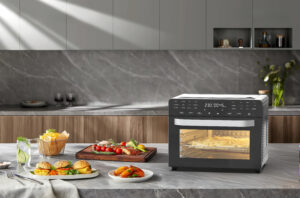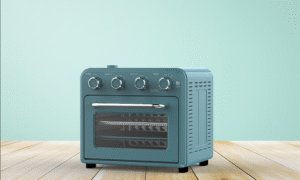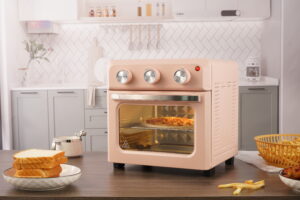As the Sales Manager at Foshan Linden Intelligent Appliances Co., Ltd., I’ve had the privilege of working with kitchen appliance buyers worldwide, from North America to the Middle East. Our factory produces top-quality 12L, 16L, and 30L air fryer ovens, air fryers, and food dehydrators, designed with innovation and style in mind. A question I often get is: Should I choose an air fryer oven or a microwave for faster, healthier cooking? I’m excited to share my expertise to help you decide which appliance fits your kitchen and lifestyle.
In this article, I’ll compare air fryer ovens and microwaves, focusing on speed, health benefits, and versatility. Drawing from my experience at Linden, where we craft appliances with customizable features, I’ll guide you through the pros and cons. Let’s explore which option is best for your home!
What Is an Air Fryer Oven?
An air fryer oven is a countertop powerhouse. It uses rapid air circulation to cook food, delivering crispy results with minimal oil. At Linden, our air fryer ovens combine frying, baking, roasting, and dehydrating functions. They’re ideal for health-conscious cooks who want versatility without clutter.
How Does an Air Fryer Oven Work?
Air fryer ovens circulate hot air at high speeds around food. This mimics deep frying but uses up to 85% less oil, according to Healthline. Our 30L air fryer oven, for instance, can roast a whole chicken or bake cookies with precision. Customizable settings allow you to tweak temperatures and times for perfect results every time.
Benefits of Air Fryer Ovens
- Healthier Cooking: Reduces fat content significantly compared to traditional frying.
- Versatility: Fries, bakes, roasts, and dehydrates in one appliance.
- Compact Design: Fits easily on countertops, perfect for small kitchens.
- Crispy Results: Achieves fried textures without excess oil.
- User-Friendly: Features intuitive controls and easy-to-clean non-stick interiors.
What Is a Microwave?
A microwave is a kitchen staple for quick heating and cooking. It uses electromagnetic waves to heat food rapidly, making it a go-to for busy households. Microwaves excel at reheating leftovers, defrosting, and preparing simple meals.
How Does a Microwave Work?
Microwaves generate electromagnetic waves that excite water molecules in food, heating it from the inside out. This process is fast but can result in uneven cooking or soggy textures for some dishes. Most microwaves offer settings for reheating, defrosting, and basic cooking.
Benefits of Microwaves
- Speed: Heats food in minutes, ideal for quick meals.
- Convenience: Simple to use for reheating and defrosting.
- Compact Options: Available in various sizes to suit different kitchens.
- Energy Efficiency: Uses less power for short cooking tasks.
- Affordability: Generally cheaper than multi-functional appliances.
Key Differences: Air Fryer Oven vs Microwave
Let’s dive into the differences to help you choose the right appliance. At Linden, we’ve seen buyers at trade shows and on our website, lindensmart.com, weigh these factors carefully. Here’s what I’ve learned.
Cooking Speed
Microwaves are the champions of speed for reheating and defrosting. They can warm a plate of leftovers in 2–3 minutes. However, for cooking raw food, air fryer ovens are often faster for certain dishes. According to Consumer Reports, air fryer ovens can cook frozen fries in 10–15 minutes, while microwaves may take longer and yield soggy results.
Our 16L air fryer oven, for example, can whip up a batch of crispy chicken wings in 20 minutes. Microwaves struggle to match that texture and flavor in the same timeframe.
Health and Nutrition
I’m passionate about healthier cooking, and air fryer ovens excel here. They use minimal oil, reducing fat content by 70–80%, per Harvard Health. This makes them ideal for low-fat diets. For instance, air-fried vegetables retain nutrients and flavor without added calories.
Microwaves are great for steaming vegetables, which preserves nutrients, according to WebMD. However, they don’t replicate the crispy textures of fried foods, and some dishes require added fats or sauces to taste good, which can offset health benefits.
Cooking Versatility
At Linden, we design air fryer ovens to be multi-functional. Our 12L, 16L, and 30L models handle frying, baking, roasting, and dehydrating. Whether you’re making a pizza or drying fruit, these appliances adapt to your needs with customizable settings.
Microwaves are less versatile. They’re best for reheating, defrosting, or cooking simple dishes like popcorn or frozen meals. For complex recipes, they often fall short, lacking the ability to brown or crisp food effectively.
Texture and Taste
Air fryer ovens deliver restaurant-quality textures. The rapid air circulation creates a crispy exterior, perfect for fries, wings, or even cakes. Our customers love the golden, crunchy results our air fryer ovens produce without excess oil.
Microwaves, on the other hand, can leave food soggy or unevenly cooked. They’re not designed to brown or crisp, which limits their appeal for recipes requiring specific textures.
Ease of Use and Cleanup
I take pride in our air fryer ovens’ user-friendly designs. They feature intuitive controls and non-stick trays that are easy to clean. Microwaves are also simple to use, with straightforward buttons for quick tasks. However, microwaves can be prone to splatters, requiring frequent interior cleaning. Air fryer ovens, with their removable baskets, are often easier to maintain.
Size and Kitchen Fit
Both appliances are countertop-friendly, but air fryer ovens offer more capacity options. Our 12L model is perfect for small households, while the 30L version suits larger families. Microwaves come in various sizes, but compact models may lack the power for complex cooking. If space is a concern, either can work, but air fryer ovens add more functionality per square inch.
Energy Consumption
Microwaves are highly energy-efficient for short tasks, using about 0.5–1 kWh per use, per Energy Star. Air fryer ovens use slightly more power, around 1–1.5 kWh, but their faster cooking times for certain dishes balance this out. For frequent cooking, air fryer ovens can be more economical than running a full-sized oven.
When to Choose an Air Fryer Oven
I recommend an air fryer oven if you:
- Want healthier meals with less oil.
- Crave crispy, restaurant-style textures.
- Need a versatile appliance for frying, baking, and more.
- Value modern designs with customizable features.
- Have a small kitchen but want big functionality.
Our 16L air fryer oven is a top pick for its balance of capacity and versatility, perfect for busy home cooks.
When to Choose a Microwave
A microwave is ideal if you:
- Need quick reheating or defrosting.
- Prioritize convenience for simple meals.
- Have a limited budget or space.
- Don’t require crispy or browned results.
Microwaves are unbeatable for speed in specific tasks, like warming leftovers or making popcorn.
Can You Use Both in Your Kitchen?
I often tell customers they don’t need to choose one over the other. An air fryer oven and a microwave complement each other beautifully. Use the microwave for quick reheating and the air fryer oven for cooking fresh, healthy meals with crispy textures. At Linden, our air fryer ovens are designed to fit seamlessly into any kitchen setup, adding style and function.
Quality and Certifications
Quality is at the heart of what we do at Linden. Our air fryer ovens undergo rigorous testing and meet international standards like UL and CE, ensuring safety and performance for global markets. When choosing a microwave, look for similar certifications to guarantee reliability and durability.
Logistics and Practical Considerations
From my experience working with buyers worldwide, logistics are key. Air fryer ovens are lightweight and easy to ship, making them ideal for international orders. Microwaves are similarly portable but offer less versatility. At Linden, we prioritize efficient production and delivery to meet tight schedules, ensuring our partners get their orders on time.
SEO-Friendly Tips for Choosing Your Appliance
To make your decision easier, here are some tips optimized for search terms like “air fryer oven vs microwave” or “best kitchen appliances”:
- Assess Your Needs: Prioritize speed, health, or versatility.
- Check Energy Use: Look for energy-efficient models to save costs.
- Consider Design: Choose an appliance that matches your kitchen aesthetic.
- Read Reviews: Check platforms like CNET for user insights.
- Test at Trade Shows: Visit events to see appliances in action.
Final Thoughts: Which Appliance Is Right for You?
As someone who’s passionate about innovative kitchen solutions, I believe air fryer ovens are the better choice for healthier, versatile cooking. Our 12L, 16L, and 30L models at Linden deliver crispy, delicious results with minimal oil, perfect for modern kitchens. Microwaves excel at speed and convenience but can’t match the texture or flexibility of air fryer ovens.
Your choice depends on your cooking habits, health goals, and kitchen space. Ready to elevate your cooking? Visit lindensmart.com to explore our air fryer ovens, or email me at sales4@fslinden.com for personalized advice. Let’s make your kitchen healthier and more exciting!
Meta Title: Air Fryer Oven vs Microwave: Faster and Healthier Cooking
Meta Description: Compare air fryer ovens and microwaves for speed and health benefits. Find the best appliance for your kitchen and cooking style.




